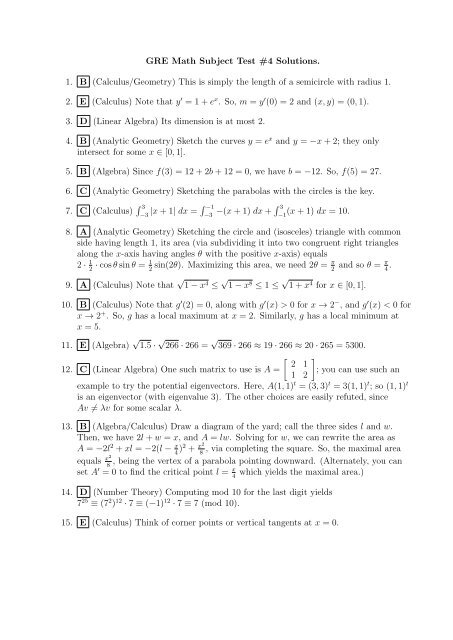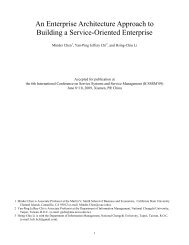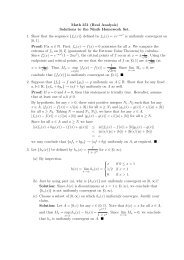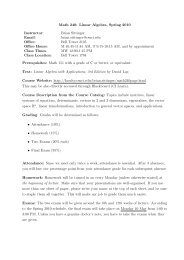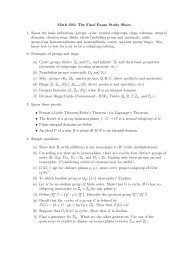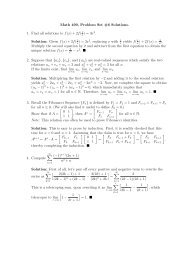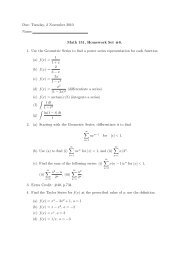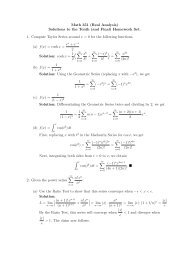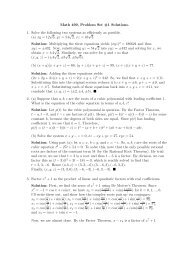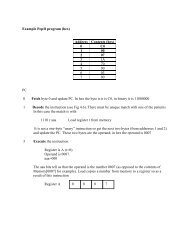GRE Math Subject Test #4 Solutions. 1. B (Calculus/Geometry) This ...
GRE Math Subject Test #4 Solutions. 1. B (Calculus/Geometry) This ...
GRE Math Subject Test #4 Solutions. 1. B (Calculus/Geometry) This ...
Create successful ePaper yourself
Turn your PDF publications into a flip-book with our unique Google optimized e-Paper software.
<strong>GRE</strong> <strong>Math</strong> <strong>Subject</strong> <strong>Test</strong> <strong>#4</strong> <strong>Solutions</strong>.<strong>1.</strong> B (<strong>Calculus</strong>/<strong>Geometry</strong>) <strong>This</strong> is simply the length of a semicircle with radius <strong>1.</strong>2. E (<strong>Calculus</strong>) Note that y ′ = 1 + e x . So, m = y ′ (0) = 2 and (x, y) = (0, 1).3. D (Linear Algebra) Its dimension is at most 2.4. B (Analytic <strong>Geometry</strong>) Sketch the curves y = e x and y = −x + 2; they onlyintersect for some x ∈ [0, 1].5. B (Algebra) Since f(3) = 12 + 2b + 12 = 0, we have b = −12. So, f(5) = 27.6. C (Analytic <strong>Geometry</strong>) Sketching the parabolas with the circles is the key.7. C (<strong>Calculus</strong>) ∫ 3|x + 1| dx = ∫ −1−(x + 1) dx + ∫ 3(x + 1) dx = 10.−3 −3 −18. A (Analytic <strong>Geometry</strong>) Sketching the circle and (isosceles) triangle with commonside having length 1, its area (via subdividing it into two congruent right trianglesalong the x-axis having angles θ with the positive x-axis) equals2 · 12 · cos θ sin θ = 1 2 sin(2θ). Maximizing this area, we need 2θ = π 2 and so θ = π 4 .9. A (<strong>Calculus</strong>) Note that √ 1 − x 4 ≤ √ 1 − x 8 ≤ 1 ≤ √ 1 + x 4 for x ∈ [0, 1].10. B (<strong>Calculus</strong>) Note that g ′ (2) = 0, along with g ′ (x) > 0 for x → 2 − , and g ′ (x) < 0 forx → 2 + . So, g has a local maximum at x = 2. Similarly, g has a local minimum atx = 5.1<strong>1.</strong> E (Algebra) √ <strong>1.</strong>5 · √266· 266 = √ 369 · 266 ≈ 19 · 266 ≈ 20 · 265 = 5300.[ ] 2 112. C (Linear Algebra) One such matrix to use is A = ; you can use such an1 2example to try the potential eigenvectors. Here, A(1, 1) t = (3, 3) t = 3(1, 1) t ; so (1, 1) tis an eigenvector (with eigenvalue 3). The other choices are easily refuted, sinceAv ≠ λv for some scalar λ.13. B (Algebra/<strong>Calculus</strong>) Draw a diagram of the yard; call the three sides l and w.Then, we have 2l + w = x, and A = lw. Solving for w, we can rewrite the area asA = −2l 2 + xl = −2(l − x 4 )2 + x2 , via completing the square. So, the maximal area8equals x2 , being the vertex of a parabola pointing downward. (Alternately, you can8set A ′ = 0 to find the critical point l = x which yields the maximal area.)414. D (Number Theory) Computing mod 10 for the last digit yields7 25 ≡ (7 2 ) 12 · 7 ≡ (−1) 12 · 7 ≡ 7 (mod 10).15. E (<strong>Calculus</strong>) Think of corner points or vertical tangents at x = 0.
16. D (<strong>Calculus</strong>) Using the disk method, the volume equals∫ ∞ 1π( √0 1+x 2) 2 ∣dx = π arctan x = π2 . 2∣ ∞ 017. B (Algebra/<strong>Calculus</strong>) Since the polynomial is of odd degree, it has at least one realroot (by the Intermediate Value Theorem). However, since f ′ (x) = 32x 4 + 8 > 0 forall x, we see that f is increasing for all x. Hence, f has exactly one real root.18. A (Linear Algebra) The subspace in question is the null space of T . So theRank-Nullity Theorem implies that it has dimension 6 − 4 = 2.19. C (<strong>Calculus</strong>/Real Analysis) Use Cauchy’s Mean Value Theorem.20. D (Real Analysis) <strong>This</strong> is reminiscent of Dirichlet’s function. For any nonzero x, wecan alternately use a sequence of rational/irrational numbers (via density ofrationals/irrationals) which converges to a given nonzero real numbers. Applying fto these sequences will yield different limits. So, f is discontinuous for all x ≠ 0.However, f is continuous at x = 0, which is most easily demonstrated with theSqueeze Theorem, because |x||x|≤ |f(x)| ≤ for all x ∈ R. Letting x → 0 yields3 2lim x→0 |f(x)| = 0, and thus lim x→0 f(x) = 0.2<strong>1.</strong> C (Number Theory) Note that 2 2 · 3 · 5 ∈ P 12 ∩ P 20 .22. B (Linear Algebra) Note that 0 is not in the set in III; so it is automatically not avector subspace. However, the other two are closed under addition and scalarmultiplication.23. A (<strong>Calculus</strong>) Note that we want y ′ = be bx = 10. Letting (x, y) denote the point ofintersection between the curve and tangent line, we solve the system y = 10x andy = e bx = 10. So, 10x = 10 yields bx = <strong>1.</strong> From here, we find that y = e bx = e 1 = eb band thus b = 10.e24. E (<strong>Calculus</strong>) Note that h(x) = e x+x2 − e x . Now, differentiate. (Alternately, use theproduct rule with the Fund. Theorem of <strong>Calculus</strong>.)25. A (Discrete <strong>Math</strong>) Repeated substitution yieldsa 30 = 31 · 30 · ... · 3 · a 29 28 2 1 = 31·30 · 1 = 15 · 3<strong>1.</strong>226. A (<strong>Calculus</strong>) Set the first partial derivatives f x = 2x − 2y and f y = −2x + 3y 2 equalto 0. In particular, the critical points are on the line y = x.27. D (Linear Algebra) Solve these as a system of linear equations (row reducing viaaugmented matrices may be useful).28. D (Discrete <strong>Math</strong>) Can you see why 1, 2, or 3 are not sufficient?29. C (<strong>Calculus</strong>) Try f(x) = x and g(x) = x + 1 for a quick counterexample.30. C (Logic) Be careful with the quantifiers.
3<strong>1.</strong> A (<strong>Calculus</strong>) Remember that dy/dx measures the slope of a tangent at a particularpoint. The given differential equation implies that dy/dx > 0; hence, the solutionmust be increasing for all x. Moreover, since lim y→±∞ (y 4 + 1) = ∞, the curvesbecomes nearly vertical when |y| is large.32. D (Abstract Algebra) I is not necessarily true if the multiplication is notcommutative. On the other hand, II and III are checked to be true via induction.33. D (Programming/Number Theory) The Euclidean Algorithm yields at the first twostages the following: 273 = 2(110) + 53 and then 110 = 2(53) + 4; the remainders are53 and 4, respectively.34. E (Analytic <strong>Geometry</strong>) <strong>This</strong> minimal distance is achieved by using the line segmentconnecting the centers (minus the lengths of the two radii).35. E (Discrete <strong>Math</strong>) Treat the men as one unit (which can be arranges in 6! ways); sowe can arrange 9 women and the group of men in 10! ways. Hence, the probabilityequals 6!·10!15!36. A (Linear Algebra) Just because any two vectors in a set are linearly independentdoes not imply that the entire set is linearly independent. For instance, look at theset {(1, 0, 0), (0, 1, 0), (1, 1, 0)}.37. D (Complex Variables/Algebra) Writing z = x + iy and expanding yields(x + iy) 2 = x 2 + y 2 . <strong>This</strong> simplifies to 2xyi − 2y 2 = y(2xi − 2y) = 0. Since x, y ∈ R,we conclude that y = 0.38. A (Discrete <strong>Math</strong>/Set Theory) Let x ∈ C. Then, f(x) ∈ f(C) and sox ∈ f −1 (f(C)). (The converse is not necessarily true if f is not 1-<strong>1.</strong>)39. B (<strong>Calculus</strong>) By the Law of Cosines, s 2 = r 2 − 2r cos 110 ◦ . Solving for s − r yields−2r cos 110◦ 2r cos 70◦s − r = = . In particular, if the limit exists, then it is positive. Next,s+rs+r2r cos 70◦ 2r cos 70◦by the triangle inequality, we know that r ≤ s + <strong>1.</strong> So, s − r = ≤ .s+r r+(r−1)Letting r, s → ∞, we have that lim r,s→∞ s − r ≤ cos 70 ◦ < <strong>1.</strong>40. C (Abstract Algebra) Consider f(x) = −x if x ≤ 0 and 0 if x > 0, and g(x) = 0 ifx ≤ 0 and x if x > 0. Then, (fg)(x) = 0 for all x ∈ R.4<strong>1.</strong> E (<strong>Calculus</strong>) By Green’s Theorem, this line integral equals∫∫(1 − (−1)) dA = 2(Area of the unit circle) = 2π.42. B (Probability) Since X and Y are independent, P (X = m ∩ Y = n) = 1 . So,2 m+nP (X > 3 ∪ Y > 3) = 1 − P (X ≤ 3 ∩ Y ≤ 3) =1 − ( 1 + 1 + 1 + 2 + 2 + 2 ) = 15.2 1+1 2 2+2 2 3+3 2 1+2 2 1+3 2 2+3 64If you do not use complements, then you will need to use the geometric series.
43. E (Algebra) Since z is a primitive fifth root of unity, we have z 5 = 1 andz 4 + z 3 + z 2 + z + 1 = 0. Repeated use of these facts reduces the expression to5z 4 = 5e 8πi/5 = −5e 3πi/5 .44. D (Probability) Since this is a binomial trial with p = q = 1 , all we need to do is2compare binomial coefficients C(100, k); the largest ones are those for which thevalues of k are near 50.45. D (Probability) In two words: Pigeonhole Principle.46. E (Abstract Algebra) All three choices yield homomorphisms.47. C (<strong>Calculus</strong>) The unit vector is 1 √2(−1, 0, 1). So, the work equals∫C ⃗ F · d⃗r = ∫ 10√12(−1, 0, 1) · (1, 2t, 3t 2 ) dt = 0.48. A (<strong>Calculus</strong>) The argument is valid.49. D (Abstract Algebra) We want the elements to all have order dividing 4. So, Z 16and Z 8 × Z 2 are not possibilities, while the remaining three Z 2 4, Z 4 × Z 2 2, and Z 4 2 are.50. B (Linear Algebra) |A 2 | = |A| 2 ≥ 0; so II is true. I is false (think of I 2 = I), and IIIis false (consider the diagonal matrix with diagonal entries 1 and −1; it square is I).5<strong>1.</strong> B (<strong>Calculus</strong>) Due to the definition of the floor function, split ths integral at everyinteger∫value:∞0 ⌊x⌋e−x dx = ∑ ∞∫ k+1k=1k·e −x dx = ∑ ∞kk=1 k(e−k −e −k−1 ) = (1−e −1 k)·∑∞k=1= 1 .e k e−1To evaluate this latter sum, differentiate the geometric series and then multiply bothsides by x: = ∑ ∞k=1 kxk . Finally, let x = <strong>1.</strong>ex(1−x) 252. B (Topology/Real Analysis) If A is closed in R, then it must contain its limitpoints, which is any element in R (as both the rational numbers and the irrationalnumbers are dense in R).53. C (<strong>Calculus</strong>) First of all, x + 4z has no critical points; so it suffices to minimizef(x, y, z) = x + 4z subject to g(x, y, z) = x 2 + y 2 + z 2 = 2. By Lagrange Multipliers,∇f = λ∇g√yields (1,√0, 4) = λ(2x, 2y, 2z). Solving this system yields the critical2points (± , 0, ±4 2) yielding the extrema ±√ 34.17 1754. E (<strong>Geometry</strong>) Let r be the radius of the little circle in the second diagram, so themid size circle has radius r(1 + √ 2). Computing the ratio of areas should now bestraightforward.55. D (Discrete <strong>Math</strong>) Recall that n! has ⌊ n 5 ⌋ + ⌊ n 5 2 ⌋ + ... zeros in its decimal expansion.Check that 400! is the first factorial ending in 99 zeros (399! ends in 98 zeros), and404! is the last such factorial. So, there are 5 possibilities.
56. E (Topology/Real Analysis) Note that the function in (E) does not satisfy thetriangle inequality: (x − 0) 2 + (y − 0) 2 ≤ (x − y) 2 is not generally true.57. E (<strong>Calculus</strong>) Simply apply the Ratio <strong>Test</strong>, and note that r = 1 ee = lim n→∞ (1 + 1 n )n will be useful.< <strong>1.</strong> The fact that58. E (Linear Algebra) All three claims are true. Writing A = P BP −1 for some P , wehave A − 2I = P BP −1 − 2I = P (B − 2I)P −1 ; so I is true.Next, II is true, because trA = tr(P B)P −1 = tr(BP )P −1 = trB.Finally, III is true, because A −1 = (P −1 ) −1 B −1 P −1 = P B −1 P −1 .59. A (Complex Analysis) Using the Cauchy-Riemann Equations, we find thatg y = u x = 2 and g x = −u y = 3. Hence g(x, y) = −3x + 2y + C. Using g(2, 3) = 1, wefind that C = <strong>1.</strong>60. E (Abstract Algebra) Examining this shape, we see that it has the reflections androtations that a regular pentagon enjoys; hence its symmetry group is D 5 of order 10.6<strong>1.</strong> C (Set Theory) Think of power sets.62. D (Topology) III is false, because [0, 1] ∪ [2, 3] is compact, but not connected. I andII are familiar properties of compact sets.63. D (<strong>Calculus</strong>) For x ≠ 0, setting f ′ (x) = 0 yields 2 critical points. However, we havea third one at x = 0, since f ′ (0) = lim h→0f(0+h)−f(0)h= 0.64. D (Real Analysis) The limiting function f equals 0 if x = 0 and 1 otherwise; hencewe have pointwise convergence. Since f is not continuous on [0, 1], the convergencefor f n (x) is not uniform on [0, 1]. The final assertion III is true by direct computation.65. B (Real Analysis/Topology) I is true; consider f(x) = 0 if x ∈ (0, 1/3], 3(x − 1/3) ifx ∈ [1/3, 2/3], and 1 otherwise. II is false, since the continuous image of a compactset is compact. As for III, note that f is either strictly increasing or decreasing sincef is a bijection. Assume that f is increasing (the other case is treated similarly), weknow that f(a) = 1 for some a ∈ (0, 1). Hence f(b) > 1 for some a < b < 1, which isa contradiction.66. B (Abstract Algebra) I is false, since R could be non-commutative. II is true,because since {0} and R are the only ideals, each element has its own multiplicativeinverse. III is false, by considering R = Z 2 .


